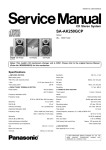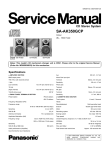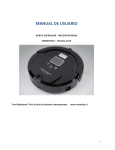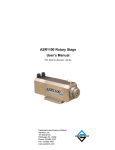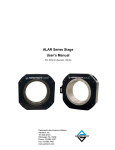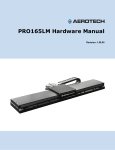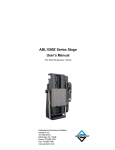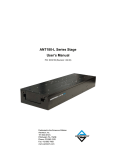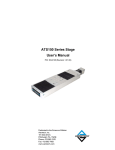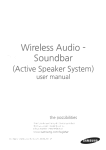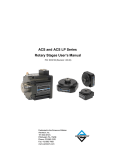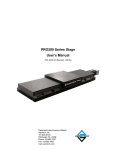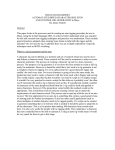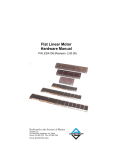Download ASRT Series Stage User`s Manual
Transcript
ASRT Series Stage User’s Manual P/N: EDS167 (Revision 1.00.00) Dedicated to the Science of Motion Aerotech, Inc. 101 Zeta Drive, Pittsburgh, PA, 15238 Phone: 412-963-7470 Fax: 412-963-7459 www.aerotech.com Product Registration Register online at: http://www.aerotech.com/prodreg.cfm Technical Support United States Headquarters: Phone: (412) 967-6440 Fax: (412) 967-6870 Email: [email protected] United Kingdom: Phone: +44 118 940 9400 Fax: +44 118 940 9401 Email: [email protected] Germany: Phone: +49 911 967 9370 Fax: +49 911 967 93720 Email: [email protected] Japan: Phone: +81(0)47-489-1741 (Sales) Phone: +81(0)47-489-1742 (Service) Fax: +81(0)47-489-1743 Email: [email protected] China: Phone: +852-3793-3488 Email: [email protected] Revision History Revision 1.00.00 June 28, 2010 Product names mentioned herein are used for identification purposes only and may be trademarks of their respective companies. © Aerotech, Inc. 2010 ASRT Series Stage User's Manual Table of Contents Table of Contents Table of Contents List of Figures List of Tables iii v vii Chapter 1: Overview 1 1.1. Standard Features 1.2. Optional Features 1.2.1. Aperture Option 1.2.2. Encoder Option 1.2.3. Accessories 1.2.4. Color Scheme 1.3. Model Numbers 1.4. Dimensions 1.5. Safety Procedures and Warnings Chapter 2: Installation 2.1. Unpacking and Handling the Stage 2.2. Preparing the Mounting Surface 2.3. Securing the Stage to the Mounting Surface 2.4. Attaching the Payload to the Stage 2.5. Electrical Installation Chapter 3: Operating Specifications 3.1. Accuracy and Temperature Effects 3.2. Basic Specifications 3.3. Standard Motor Wiring 3.4. Ground Attachments 3.5. Desiccant Cartridge 3.6. Air Purge Fitting 3.7. Horizontal Axis of Rotation Mounting Chapter 4: Maintenance 4.1. Service and Inspection Schedule 4.2. Cleaning and Lubrication 4.2.1. Recommended Cleaning Solvents 2 3 3 3 3 3 4 5 8 9 9 10 11 13 14 15 15 16 18 20 21 22 23 25 25 27 27 Appendix A: Glossary 29 Appendix B: Warranty and Field Service 35 Appendix C: Technical Changes 37 Index 39 Reader's Comments 41 www.aerotech.com iii Table of Contents iv ASRT Series Stage User's Manual www.aerotech.com ASRT Series Stage User's Manual List Of Figures List of Figures Figure 1-1: Figure 1-2: Figure 1-3: Figure 1-4: Figure 2-1: Figure 2-2: Figure 2-3: Figure 2-4: Figure 2-5: Figure 3-1: Figure 3-2: Figure 3-3: Figure 3-4: Figure 3-5: Figure 3-6: Figure 3-7: Figure 3-8: Figure 3-9: Figure 3-10: Figure 4-1: Figure 4-2: Standard ASRT Rotary Stage ASRT-185 Dimensions ASRT-245 Dimensions ASRT-300 Dimensions Results of Flat Versus Non-Flat Mounting Vertical Axis of Rotation Mounting Counter-bored Holes Vertical Axis of Rotation Flange Mounting Through Holes Horizontal Axis of Rotation Side Mounting Tapped Holes Electrical Connectors and Grounds ASRT Series Torque Capacity ASRT Series Current Capacity Motor Power Connector Motor Feedback Connector Housing Ground Lug Location Tabletop Ground Lug Location Desiccant Cartridge Access Screws Air Purge Fitting Accessory External Cover Removal Drainage Plug Location Rear Cover and Brushes Location Rear Shaft Cover and Brushes Location www.aerotech.com 1 5 6 7 10 11 11 12 14 17 17 18 18 20 20 21 22 23 23 25 26 v List of Figures vi ASRT Series Stage User's Manual www.aerotech.com ASRT Series Stage User's Manual List of Tables List of Tables Table 1-1: Table 3-1: Table 3-2: Table 3-3: Table C-1: Table C-2: Model Numbering System ASRT Series Specifications Motor Power Connector Pin Assignment Motor Feedback Connector Pin Assignment Current Changes (1.00.00) Archived Changes www.aerotech.com 4 16 18 19 37 38 vii List of Tables viii ASRT Series Stage User's Manual www.aerotech.com ASRT Series Stage User's Manual Overview Chapter 1: Overview The ASRT is a continuous travel sealed rotary table. This chapter introduces standard and optional features of the ASRT stages, explains the model numbering system, and gives general safety precautions. Figure 1-1: Standard ASRT Rotary Stage N O T E : Aerotech continually improves its product offerings, and listed options can be superseded at any time. Refer to the Aerotech Motion Control Product Guide for the most current product information at www.aerotech.com. www.aerotech.com Chapter 1 1 Overview ASRT Series Stage User's Manual 1.1. Standard Features All ASRT stages incorporate a direct drive brushless motor. The maintenance free direct drive and slotless motor design combine to create outstanding angular positioning and velocity control. This is especially useful in scanning applications where torque ripple cannot be tolerated. Other added benefits of the direct drive are zero backlash and higher speeds. Every ASRT stage is designed around a set of angular contacts used to maximize performance with respect to tilt error, moment stiffness, and rotating friction. A precision-machined shaft further minimizes tilt error. The design incorporates integral connections that minimize cable issues. ASRT stage performance is assured with resolutions from 0.02 arc-sec/count to 0.036 arc-sec/count. The motor and high-performance rotary encoder are directly coupled to a common shaft. All ASRT stages are fully grounded. Internal brushes provide the attached payload with up to 20 amps of grounding capability. The grounding system is designed to protect against electrical shock and eliminate RF re-radiation, and housing grounding points are included. Circular sealed connectors are included. All ASRT stages can handle between 66 and 400 lb of axial load. All ASRT stages are design to operate in harsh environments. The stage can operate in environments with dust, fluid jets, or cutting fluids. Internal mechanics and electronics are enclosed in a IP66 rated housing. Furthermore, the stage is capable of operating in temperatures ranging from –20 C° to 70 C°. 2 Chapter 1 www.aerotech.com ASRT Series Stage User's Manual Overview 1.2. Optional Features 1.2.1. Aperture Option The optional aperture in the ASRT series ranges from 30 mm to 130 mm in diameter. 1.2.2. Encoder Option The ASRT series of rotary stages are available with either optical or magnetic encoder systems. Optical encoders provide outstanding accuracy and repeatability while magnetic encoders provide exceptional environmental protection. 1.2.3. Accessories Several accessories are available for the ASRT series. They include: l Desiccant Cartridge: A re-usable desiccant cartridge is available for high humidity applications. l Air Purge Fitting: For maximum operating temperature ranges, an air purge fitting provides access to the interior of the stage. A minimum of 10 psi of clean, dry nitrogen applied to the interior prevents condensation and provides a means to operate the stage in extreme temperature ranges ( -20 C° to 70 C°). l Mounting Flange: For applications requiring easy access to mounting hardware, the mounting flange provides a convenient method to do so. l Covers: For horizontal mounting applications in hostile environments, a set of covers are available to further protect the stage. These covers add another barrier from incoming water jets and dust. 1.2.4. Color Scheme A polymer-based paint on the housing and a hard-coated tabletop is standard for corrosion protection. The stage has optional Desert Tan, Army Green, Navy Grey, Black, and White paint colors. www.aerotech.com Chapter 1 3 Overview ASRT Series Stage User's Manual 1.3. Model Numbers The stage model number indicates the optional features on a particular stage. To determine the options on your stage, refer to Table 1-1 for an explanation of the numbering system. Table 1-1: Model Numbering System ASRT Series Direct Drive Rotary Stage ASRT-185 185 mm wide direct-drive sealed rotary table, unlimited travel ASRT-245 245 mm wide direct-drive sealed rotary table, unlimited travel ASRT-300 300 mm wide direct-drive sealed rotary table, unlimited travel Model Option -A Optional aperture Encoder Option -O High accuracy encoder option (1 Vpp output) -M Magnetic encoder option (1 Vpp output); available with -185 and -245 models only) Acessories -D Desiccant cartidge -P Air purge fitting -F Mounting flange -C Cover for horizontal axis orientation Color Scheme 4 -BLK Black polymer based exterior paint -WHT White polymer based exterior paint -GRN Green polymer based exterior paint -GRY Gray polymer based exterior paint -TAN Desert tan polymer based exterior paint Chapter 1 www.aerotech.com ASRT Series Stage User's Manual Overview 1.4. Dimensions Figure 1-2: www.aerotech.com ASRT-185 Dimensions Chapter 1 5 Overview ASRT Series Stage User's Manual Figure 1-3: 6 ASRT-245 Dimensions Chapter 1 www.aerotech.com ASRT Series Stage User's Manual Figure 1-4: www.aerotech.com Overview ASRT-300 Dimensions Chapter 1 7 Overview ASRT Series Stage User's Manual 1.5. Safety Procedures and Warnings The following statements apply throughout this manual. Failure to observe these precautions could result in serious injury to those performing the procedures and/or damage to the equipment. To minimize the possibility of electrical shock and bodily injury, confirm that all electrical power is disconnected prior to making any electrical connections. To minimize the possibility of electrical shock and bodily injury when any electrical circuit is in use, ensure that no person comes in contact with the circuitry when the stage is connected to a power source. To minimize the possibility of bodily injury, confirm that all electrical power is disconnected prior to making any mechanical adjustments. Care must be exercised that all personnel remain clear of any moving parts. 8 Chapter 1 www.aerotech.com ASRT Series Stage User's Manual Installation Chapter 2: Installation This chapter describes the installation procedure for the ASRT stage, including handling the stage properly, preparing the stage environment, securing the stage to the mounting surface, attaching the payload, and making the electrical connections. 2.1. Unpacking and Handling the Stage Carefully remove the stage from the protective shipping container. Blow the stage off with compressed nitrogen or clean, oil-less air. Before operating the stage, it is important to let the stage stabilize at room temperature for at least 12 hours. Each stage has a label listing the system part number and serial number. These numbers contain information necessary for maintaining or updating system hardware and software. Locate this label and record the information for later reference. If any damage has occurred during shipping, report it immediately. Improper stage handling could adversely affect the stage’s performance. Use care when moving the stage. Lift the stage only by the base. Do not use the tabletop or wiring connections to support the stage. www.aerotech.com Chapter 2 9 Installation ASRT Series Stage User's Manual 2.2. Preparing the Mounting Surface The mounting surface should be flat and have adequate stiffness in order to achieve the maximum performance from the ASRT. When an ASRT series stage is mounted to a non-flat surface, the stage can be distorted as the mounting screws are tightened. This distortion will decrease the overall accuracy of the stage. To maintain accuracy, the mounting surface should be flat to ±13 μm (±0.0005 in). Adjustments to the mounting surface must be done before the stage is secured. The effects of flatness on mounting are illustrated in Figure 2-1. Figure 2-1: Results of Flat Versus Non-Flat Mounting N O T E : The stage base is precision machined and verified for flatness prior to stage assembly at the factory. If machining is required to achieve the desired flatness, it should be performed on the mounting surface rather than the stage base. Shimming should be avoided if possible. If shimming is required, it should be minimized to improve the rigidity of the system. 10 Chapter 2 www.aerotech.com ASRT Series Stage User's Manual Installation 2.3. Securing the Stage to the Mounting Surface ASRT series stages have a fixed mounting pattern available to secure the stage to a mounting surface. Figure 2-2 through Figure 2-4 shows the main mounting holes in the base of the stage. These counter-bored and through holes are designed for 6 mm socket head cap screws for the ASRT-245 and smaller models and M8 socket head cap screws for the ASRT-300 model. Side mounting tapped holes are M8x1.25 holes for the ASRT-245 and larger models, and M6x1 for the ASRT-185 model. Figure 2-2: Vertical Axis of Rotation Mounting Counter-bored Holes Figure 2-3: Vertical Axis of Rotation Flange Mounting Through Holes www.aerotech.com Chapter 2 11 Installation ASRT Series Stage User's Manual Figure 2-4: 12 Horizontal Axis of Rotation Side Mounting Tapped Holes Chapter 2 www.aerotech.com ASRT Series Stage User's Manual Installation 2.4. Attaching the Payload to the Stage To prevent damage to payloads, test the operation of the stage before the payload is attached to the stage table. Proceed with the electrical installation and test the motion control system in accordance with the system documentation. Document all results for future reference. For information on electrical connections, refer to the documentation of the motion control system or the wiring drawings in Chapter 3: Operating Specifications www.aerotech.com Chapter 2 13 Installation ASRT Series Stage User's Manual 2.5. Electrical Installation Aerotech motion control systems are adjusted at the factory for optimum performance. When the ASRT series stage is part of a complete Aerotech motion control system, setup involves connecting a stage and motor combination to the appropriate drive chassis with the cables provided. Connect the provided cables to the appropriate electrical connectors and grounds on the ASRT shown in Figure 2-5. Labels on the drive indicate the drive connector locations. Refer to your drive manuals and documentation for additional installation and operation information. Figure 2-5: Electrical Connectors and Grounds In some cases, if the system is uniquely configured, a drawing showing system interconnects is supplied. See Section 3.3. for more information on the electrical connections on the ASRT, including pinouts. Never connect or disconnect any electrical component or connecting cable while power is applied, or serious damage may result. N O T E : Refer to the controller documentation to adjust servo gains for optimum velocity and position stability. 14 Chapter 2 www.aerotech.com ASRT Series Stage User's Manual Operating Specifications Chapter 3: Operating Specifications This chapter contains general technical information about ASRT series stages. Included are basic product specifications, resolution information, and motor wiring diagrams. 3.1. Accuracy and Temperature Effects ASRT series stages are tested for accuracy in a 20° C (68° F) environment. Operating at other temperatures will cause the accuracy to deviate from the specifications listed in this manual. www.aerotech.com Chapter 3 15 Operating Specifications ASRT Series Stage User's Manual 3.2. Basic Specifications The ASRT series rotary stage specifications are shown in Table 3-1. Torque capacities are given in Figure 31 and current capacities are given in Figure 3-2. Table 3-1: ASRT Series Specifications Basic Model Total Travel ASRT-185 Aperture Diameter (Optional) ASRT-245 Unlimited ASRT-300 30 mm 80 mm 130 mm Width 185 mm sq. 245 mm sq. 300 mm sq. Height 100 mm 65 mm 100 mm Mechanical Drive System Direct-Drive Brushless Slotless Servomotor Continuous Current See Figure 3-2 Maximum Torque See Figure 3-1 Continuous Torque See Figure 3-1 981 rad/s2 Maximum Acceleration Accuracy, Uncalibrated (Optical) Accuracy, Calibrated (Optical) (1) 2 arc sec Repeatability (Optical) (1) 2 arc-sec (1) 60 arc sec 50 arc sec Accuracy, Calibrated (Magnetic) (1) 12 arc sec Repeatability (Magnetic) 10 arc-sec Tilt Error (1) 40 arc sec 3 arc sec Maximum Rotary Speed Resolution (Optical) 650 rad/s2 10 arc sec (1) Accuracy, Uncalibrated (Magnetic) 922 rad/s2 (2) (3) Resolution (Magnetic) (3) Maximum Axial Load Capability Maximum Radial Load Capability Maximum Moment Load Capability Standard Finish 200 rpm 150 rpm 100 rpm 0.036 arc sec 0.027 arc sec 0.018 arc sec 0.63 arc sec 0.54 arc sec 0.32 arc sec 30.6 kg 142.8 kg 173.4 kg 25 kg 115 kg 140 kg 175 N-m 425 N-m 500 N-m Painted Housing with Hard-Coated Table Top Weight 10.3 kg 18.8 kg 25 kg Weight with Aperture 12.6 kg 21.9 kg 29 kg Inertia (4) Inertia with Aperture (4) 0.0096 kg*m2 0.013 kg*m2 kg*m2 0.066 kg*m2 0.039 kg*m2 0.079 kg*m2 0.026 (1) Accuracies, repeatability, and tilt errors are at 20 C°. (2) Speeds may be limited below 0 C° depending on application. Maximum speed based on stage capability; maximum application velocity may be limited by system data rate, resolution and bus voltage . (3) Range is consistent with 500x multiplication . (4) Unloaded inertia. 16 Chapter 3 www.aerotech.com ASRT Series Stage User's Manual www.aerotech.com Operating Specifications Figure 3-1: ASRT Series Torque Capacity Figure 3-2: ASRT Series Current Capacity Chapter 3 17 Operating Specifications ASRT Series Stage User's Manual 3.3. Standard Motor Wiring Stages come from the factory completely wired and assembled. For reference, connector pin assignments and general wiring information are given in the following figures and tables. N O T E : Refer to the other documentation accompanying your Aerotech equipment. Call your Aerotech representative if there are any questions on system configuration. Figure 3-3: Table 3-2: Pin # A Motor Power Connector Pin Assignment Pin Output MTR ØA Description Motor Phase A B MTR ØB Motor Phase B C MTR ØC Motor Phase C D SHIELD Shield for motor wiring connector E FRM GND Ground to stage base Figure 3-4: 18 Motor Power Connector Motor Feedback Connector Chapter 3 www.aerotech.com ASRT Series Stage User's Manual Table 3-3: Operating Specifications Motor Feedback Connector Pin Assignment Pin # 1 Pin Output COS Description Cosine. Incremental encoder output; either TTL line driven or amplified sine wave type signal. COS leads SIN for CW motor rotation. 2 COS-N 3 SIN 4 SIN-N Incremental encoder output. Complement of sine. 5 MKR Marker. Incremental encoder output pulse given once per revolution. Typically used for home reference cycle. 6 MKR-N Marker N. Incremental encoder output; either the complement of Marker with a line driven, TTL type encoder or 2.5 V DC bias level with amplified sine wave type encoder. 9 HALL A Hall Effect A. Brushless motor commutation track output. TTL line driven signal with rotary motor. 10 HALL B Hall Effect B. Brushless motor commutation track output. TTL line driven signal with rotary motor. 11 HALL C Hall Effect C. Brushless motor commutation track output. TTL line driven signal with rotary motor. 12 THERMISTOR Motor thermistor. 15 CW/+ LMT Clockwise end of travel limit (option). 16 CCW/-LMT Counterclockwise end of travel limit (option). 19 OUTER SHLD 20 ENCODER +5V +5 V supply input for optical encoders. Typical requirement is 250 mA. 21 ENCODER COM +5 V return for optical encoders (ground). 24 HALL COM Return for hall effects (ground). 25 HALL +5V +5 V supply for hall effects. 26 THERMISTOR COM Return for motor thermistor (ground). 28 LIMIT COM Common ground for limit switch. 29 LIMIT +5V +5 V supply for limit switch. 31 ENCODER +5V +5 V supply input for optical encoders. Typical requirement is 250 mA. 32 ENCODER COM + V return for optical encoders (ground). www.aerotech.com Incremental encoder output. Complement of cos. Sine. Incremental encoder output; either TTL line driven or amplified sine wave type signal. COS leads SIN for CW motor rotation. Shield for feedback connector. Chapter 3 19 Operating Specifications ASRT Series Stage User's Manual 3.4. Ground Attachments ASRT series stages come with two ground lugs: one for stage ground and one for payload ground. The stage ground is located adjacent to the connectors, and the payload ground is located on the tabletop. 20 Figure 3-5: Housing Ground Lug Location Figure 3-6: Tabletop Ground Lug Location Chapter 3 www.aerotech.com ASRT Series Stage User's Manual Operating Specifications 3.5. Desiccant Cartridge You can access the optional Desiccant Cartridge accessory from the side of the stage, as shown in Figure 37. The cartridge is secured with four M4 button head screws. It is sealed to the stage with a gasket between the housing and the cartridge flange. Figure 3-7: www.aerotech.com Desiccant Cartridge Access Screws Chapter 3 21 Operating Specifications ASRT Series Stage User's Manual 3.6. Air Purge Fitting You can access the optional Air Purge fitting between the motor and feedback connectors. The fitting is threaded with an optional 1/8 NPT pipe thread. Without this option, the ASRT ships with a 1/8 NPT plug. All threads are coated with Teflon tape at the factory to ensure good sealing. Figure 3-8: 22 Air Purge Fitting Accessory Chapter 3 www.aerotech.com ASRT Series Stage User's Manual Operating Specifications 3.7. Horizontal Axis of Rotation Mounting In applications requiring a horizontal axis of rotation in hostile environments, a set of external covers are available. These covers are factory installed and are necessary to protect the ASRT from ingress of dust and water. The mounting surface for the ASRT in this orientation is also the connector face. This keeps contaminants away from the connectors. To remove the external covers, remove the screws shown in Figure 39. Figure 3-9: External Cover Removal When mounting the ASRT in this orientation, remove the drainage plug on the mounting surface. This will allow any water built up inside the stage to drain off. Any mounting fixturing should leave access to the connectors, air fitting, and ground lug. The fixturing should also have a water channel around the hole plug to allow adequate drainage. Figure 3-10: www.aerotech.com Drainage Plug Location Chapter 3 23 Operating Specifications 24 ASRT Series Stage User's Manual Chapter 3 www.aerotech.com ASRT Series Stage User's Manual Maintenance Chapter 4: Maintenance ASRT series stages are designed to be maintenance free positioning systems. Periodic inspection and cleaning is recommended. To minimize the possibility of bodily injury, confirm that all electrical power is disconnected prior to making any mechanical adjustments. 4.1. Service and Inspection Schedule You should inspect the ASRT a minimum of once per month until a trend develops for the specific application and environment. You should periodically inspect or service the following stage features: l Drainage Plumbing: The ASRT rotary table has an internal channel to allow water buildup that can occur in some environments. You should purge water from this area by removing four drainage plugs located on the four sides of the ASRT housing (see Figure 3-10). Supply dry nitrogen at a minimum pressure of 10 psi to the interior of the stage by means of the factory supplied optional air purge fitting or by removing the 1/8 NPT plug (see Figure 3-8) and supplying nitrogen to the opening. Reinstall all plugs after flushing trapped water. l Ground Brushes: Periodic inspection and replacement of the ground brushes is necessary to maintain adequate electrical protection. The grounding brushes differ depending on the options purchased. l Standard Option: Plunger style spring loaded brushes are used with the standard ASRT rotary table. You can access them by removing the screws securing the housing rear cover. The brushes are located on the inside surface of the cover. Replace brushes if the brush stroke is less than 1/8". To replace a brush, remove the support bracket from the cover, loosen the set screws securing the brush assemblies, and slide the brushes out of the holder. Clean surrounding parts of brush debris with isopropyl alcohol and install new brushes. Figure 4-1: www.aerotech.com Rear Cover and Brushes Location Chapter 4 25 Maintenance l ASRT Series Stage User's Manual Aperture Option: Leaf style spring loaded brushes are used with the ASRT rotary table with the aperture option. You can access them by removing the screws securing the shaft rear cover. The brushes are mounted to the inside surface of the rear housing. Replace brushes if the brush contact material is less than 1/16" thick. To replace a brush, remove the two screws securing each leaf spring brush. Clean surrounding parts of brush debris with isopropyl alcohol and install new brushes. Replace the rear shaft cover by applying pressure while twisting the cover. Insert screws but do not tighten them. Rotate the shaft one turn to make sure the cover does rub against the housing, and then tighten the screws. Figure 4-2: l Rear Shaft Cover and Brushes Location Desiccant Cartridge: You should periodically inspect the desiccant inside the cartridge. Desiccant turns from blue to clear-pinkish-white when saturated. The time required for this change to take place depends on application humidity levels. Two replacement options are available. You can contact the factory for replacement cartridges or bake the cartridge at 350 °F for two hours or until the desiccant turns blue again. You can remove the cartridge by removing the four screws securing the unit on the side of the housing as shown in fig. In you have purchased the cover option, you must remove the covers to access the cartridge. Remove the cover's 12 button head screws and slide the covers off. Replace the cartridge and covers. The cartridge is sealed via a gasket. The gasket must be in place between the cartridge flange and housing to assure adequate water jet and dust protection. Contact the factory for replacement if the gasket is damaged. 26 Chapter 4 www.aerotech.com ASRT Series Stage User's Manual Maintenance 4.2. Cleaning and Lubrication There are no elements on the ASRT that require added lubrication. The bearings, motors, and encoders for the ASRT require no added lubrication or maintenance. Periodic cleaning is recommended. 4.2.1. Recommended Cleaning Solvents Before using a cleaning solvent on any part of the stage, use compressed nitrogen or clean, dry air to blow away small particles and dust. You can clean any metal surface of the stage with isopropyl alcohol on a lint free cloth. To minimize the possibility of bodily injury, confirm that all electrical power is disconnected prior to making any mechanical adjustments. www.aerotech.com Chapter 4 27 Maintenance 28 ASRT Series Stage User's Manual Chapter 4 www.aerotech.com ASRT Series Stage User's Manual Glossary Appendix A: Glossary Abbe Error Abbe Offset Absolute Move The positioning error resulting from angular motion and an offset between the measuring device and the point of interest. The value of the offset between the measuring device and the point of interest. A move referenced to a known point or datum. Absolute ProA positioning coordinate reference where all positions are specified relative to a reference or “home” position. gramming AC Brushless A servomotor with stationary windings in the stator assembly and permanent magnet rotor. AC brushless genServo erally refers to a sinusoidally wound motor (such as BM series) to be commutated via sinusoidal current waveform. (see DC brushless servo) Acceleration The change in velocity as a function of time. Accuracy An absolute measurement defining the difference between actual and commanded position. Accuracy Grade In reference to an encoder grating, accuracy grade is the tolerance of the placement of the graduations on the encoder scale. ASCII American Standard Code for Information Interchange. This code assigns a number to each numeral and letter of the alphabet. Information can then be transmitted between machines as a series of binary numbers. Axial Runout Positioning error of the rotary stage in the vertical direction when the tabletop is oriented in the horizontal plane. Axial runout is defined as the total indicator reading on a spherical ball positioned 50 mm above the tabletop and centered on the axis of rotation. Axis of RotaA centerline about which rotation occurs. tion Back emf, The voltage generated when a permanent magnet motor is rotated. This voltage is proportional to motor speed Kemf and is present whether or not the motor windings are energized. Backlash Acomponent of bidirectional repeatability,it is the non-responsivenessof the system load to reversal of input command. Ball Screw A precision device for translating rotary motion into linear motion. A lead screw is a low-cost lower performance device performing the same function. Unit consists of an externally threaded screw and an internally threaded ball nut. Ball Screw The linear distance a carriage will travel for one revolution of the ball screw (lead screw). Lead Bandwidth A measurement, expressed in frequency (hertz), of the range which an amplifier or motor can respond to an input command from DC to -3dB on a frequency sweep. Baud Rate BCD The number of bits transmitted per second on a serial communication channel such as RS-232 or modem. Binary Coded Decimal - A number system using four bits to represent 0-F (15). Bearing A support mechanism allowing relative motion between two surfaces loaded against each other. This can be a rotary ball bearing, linear slide bearing, or air bearing (zero friction). Bidirectional Repeatability CAM Profile See Repeatability. A technique used to perform nonlinear motion that is electronically similar to the motion achieved with mechanical cams. www.aerotech.com Appendix A 29 Glossary ASRT Series Stage User's Manual Cantilevered A load not symmetrically mounted on a stage. Load Closed Loop A broad term relating to any system where the output is measured and compared to the input. Output is adjusted to reach the desired condition. CNC Computer Numerical Control. A computer- based motion control device programmable in numerical word address format. Coefficient of Defined as the ratio of the force required to move a given load to the magnitude of that load. Friction Cogging Nonuniform angular/linear velocity. Cogging appears as a jerkiness, especially at low speeds, and is due to magnetic poles attracting to steel laminations. Commutation The action of steering currents to the proper motor phases to produce optimum motor torque/force. In brushtype motors, commutation is done electromechanically via the brushes and commutator. A brushless motor is electronically commutated using a position feedback device such as an encoder or Hall effect devices. Stepping motors are electronically commutated without feedback in an open-loop fashion. Commutation, Also referred to as trapezoidal commutation. The process of switching motor phase current based on three Hall 6-Step effectsignals spaced 120 electrical degrees beginning 30 degreesinto the electrical cycle. This method is the easiest for commutation of brushless motors. Commutation, Also referred to as modified sine commutation. The process of switching motor phase current based on three Modified 6- Halleffect signals spaced 120 electricaldegrees beginning at 0 electrical degrees.This method is slightly more difStep ficult to implement than standard 6- step, but more closely approximates the motor’s back emf. The result is smoother control and less ripple. Aerotech’s BA series self-commutate using this method. Commutation, The process of switching motor phase current based on motor position information, usually from an encoder. In Sinusoidal this method, the three phase currents are switched in very small increments that closely resemble the motor’s back emf. Sinusoidal commutation requires digital signal processing to convert position information into threephase current values and, consequently, is most expensive to implement. The result, however, is the best possible control. All Aerotech controllers, as well as the BAS series amplifiers, commutate using this method. Connectorized Ports Machined features in the back of the motor which support connector hardware. Coordinated Multi-axis motion where the position of each axis is dependent on the other axis, such that the path and velocity of Motion a move can be accurately controlled. Drawing a circle requires coordinated motion. Critical Speed A term used in the specification of a lead screw or ball screw indicating the maximum rotation speed before resonanceoccurs. This speed limitis a function ofthe screw diameter, distancebetween support bearings, and bearing rigidity. Current Com- Motor driver or amplifier configuration where the input signal is commanding motor current directly, which transmand lates to motor torque/force at the motor output. Brushless motors can be commutated directly from a controller that can output current phase A and B commands. Current, Peak An allowable current to run a motor above its rated load, usually during starting conditions. Peak current listed on a data sheet is usually the highest current safely allowed to the motor. Current, rms Root Mean Square. Average of effective currents over an amount of time. This current is calculated based on the load and duty cycle of the application. Cycle When motion is repeated (move and dwell) such as repetitive back-and-forth motion. DC Brushless A servomotor with stationary windings in the stator assembly and permanent magnet rotor. (See AC Brushless Servo Servo) Deceleration The change in velocity as a function of time. 30 Appendix A www.aerotech.com ASRT Series Stage User's Manual Glossary Duty Cycle For a repetitive cycle, the ratio of “on” time to total cycle time used to determine a motor’s rms current and torque/force. Dwell Time Time in a cycle at which no motion occurs. Used in the calculation of rms power. Efficiency Ratio of input power vs. output power. Electronic Technique used to electrically simulate mechanical gearing. Causes one closed loop axis to be slaved to another Gearing open or closed loop axis with a variable ratio. Encoder Marker Once-per-revolution signal provided by some incremental encoders to accurately specify a reference point within that revolution. Also known as Zero Reference Signal or Index Pulse. Encoder Res- Measure of the smallest positional change which can be detected by the encoder. A 1000- line encoder with a olution quadrature output will produce 4000 counts per revolution. Encoder, IncrePosition encoding device in which the output is a series of pulses relative to the amount of movement. mental Feedback Signal that provides process or loop information such as speed, torque, and position back to the controller to produce a “closed loop” system. Flatness (of travel) Measure of the vertical deviation of a stage as it travels in a horizontal plane. Force, Continuous The value of force that a particular motor can produce in a continuous stall or running (as calculated by the rms values) condition. Force, Peak The maximum value of force that a particular motor can produce. When sizing for a specific application, the peak force is usually that required during acceleration and deceleration of the move profile. The peak force is used in conjunction with the continuous force and duty cycle to calculate the rms force required by the application. Friction The resistance to motion between two surfaces in contact with each other. G.P.I.B. A standard protocol, analogous to RS-232, for transmitting digital information. The G.P.I.B. interface (IEEE-488) transmits data in parallel instead of serial format. (See IEEE-488) Gain Comparison or ratio of the output signal and the input signal. In general, the higher the system gain, the higher the response. Grating Period Actual distance between graduations on an encoder. Hall Effect Sensors HED Home Feedback device (HED) used in a brushless servo system to provide information for the amplifier to electronically commutate the motor. Hall Effect Device. (See Hall Effect Sensors) Reference position for all absolute positioning movements. Usually defined by a home limit switch and/or encoder marker. Home Switch A sensor used to determine an accurate starting position for the home cycle. Hysteresis A component of bidirectional repeatability. Hysteresis is the deviation between actual and commanded position and is created by the elastic forces in the drive systems. I/O Input / Output. The reception and transmission of information between control devices using discrete connection points. IEEE-488 Incremental A set of codes and formats to be used by devices connected via a parallel bus system. This standard also defines communication protocols that are necessary for message exchanges, and further defines common commands and characteristics. (See G.P.I.B.) A move referenced from its starting point (relative move). www.aerotech.com Appendix A 31 Glossary ASRT Series Stage User's Manual Move Inertia Lead Error The physical property of an object to resist changes in velocity when acted upon by an outside force. Inertia is dependent upon the mass and shape of an object. The deviation of a lead screw or ball screw from its nominal pitch. Lead Screw Adevice for translating rotarymotion into linear motion. Unitconsists of an externallythreaded screw and an internally threaded carriage (nut). (See Ball Screw) Life The minimum rated lifetime of a stage at maximum payload while maintaining positioning specifications. Limit Switch A sensor used to determine the end of travel on a linear motion assembly. Limits Sensors called limits that alert the control electronics that the physical end of travel is being approached and motion should stop. Linear Motor A motor consisting of 2 parts, typically a moving coil and stationary magnet track. When driven with a standard servo amplifier, it creates a thrust force along the longitudinal axis of the magnet track. Load Carrying The maximum recommended payload that does not degrade the listed specifications for a mechanical stage. Capability Master-Slave Type of coordinated motion control where the master axis position is used to generate one or more slave axis position commands. Motion Profile A method of describing a process in terms of velocity, time, and position. Motor Brush The conductive element in a DC brush-type motor used to transfer current to the internal windings. Motor, Brushless Type of direct current motor that utilizes electronic commutation rather than brushes to transfer current. Motor, Step- Specialized motor that allows discrete positioning without feedback. Used for noncritical, low power applications, ping since positional information is easily lost if acceleration or velocity limits are exceeded. NC NEMA Non-Volatile Memory Open Collector Numerical Control. Automated equipment or process used for contouring or positioning. (See CNC) National Electrical Manufacturer’s Association. Sets standards for motors and other industrial electrical equipment. Memory in a system that maintains information when power is removed. A signal output that is performed with a transistor. Open collector output acts like a switch closure with one end of the switch at circuit common potential and the other end of the switch accessible. Open Loop Control circuit that has an input signal only, and thus cannot make any corrections based on external influences. Operator Interface Optical Encoder Device that allows the operator to communicate with a machine. A keyboard or thumbwheel is used to enter instructions into a machine. (See HMI or MMI) A linear or angular position feedback device using light fringes to develop position information. Opto-isolated System or circuit that transmits signal with no direct electrical connections, using photoelectric coupling between elements. Orthogonality The condition of a surface or axis perpendicular (offset 90°) to a second surface or axis. Orthogonality specification refers to the error from 90° from which two surfaces of axes are aligned. Overshoot In a servo system, referred to the amount of velocity and/or position overrun from the input command. Overshoot isa result of many factors including mechanical structure,tuning gains, servo controller capability, and inertial mis- 32 Appendix A www.aerotech.com ASRT Series Stage User's Manual Glossary match. PID Pitch (of travel) Pitch Error PLC A group of gain terms in classical control theory (Proportional Integral Derivative) used in compensation of a closed-loop system. The terms are optimally adjusted to have the output response equal the input command. Aerotech controllers utilize the more sophisticated PID FVFA loop which incorporates additional terms for greater system performance. Angular motion of a carriage around an axis perpendicular to the motion direction and perpendicular to the yaw axis. Positioning error resulting from a pitching motion. Programmable Logic Controller. A programmable device that utilizes “ladder logic” to control a number of input and output discrete devices. PWM Pulse Width Modulation. Switch-mode technique used in amplifiers and drivers to control motor current. The output voltage is constant and switched at the bus value (160 VDC with a 115 VAC input line). Quadrature Refers to the property of position transducers that allows them to detect direction of motion using the phase relationship of two signal channels. A 1000-line encoder will yield 4000 counts via quadrature. Radial Runout Positioning error of the rotary stage in the horizontal direction when the tabletop is oriented in the horizontal plane. Radial runout is defined as the total indicator reading on a spherical ball positioned 50 mm above the tabletop and centered on the axis of rotation. Ramp Time Range Time it takes to accelerate from one velocity to another. The maximum allowable travel of a positioning stage. RDC Resolver to Digital Converter. Electronic component that converts the analog signals from a resolver (transmitter type) into a digital word representing angular position. Repeatability The maximum deviation from the mean (each side) when repeatedly approaching a position. Unidirectional repeatability refers to the value established by moving toward a position in the same direction. Bidirectional repeatability refers to the value established by moving toward a position in the same or opposite direction. Resolution The smallest change in distance that a device can measure. Retroreflector An optical element with the property that an input light beam is reflected and returns along the same angle as the input beam. Used with laser interferometers. Roll (of travel) Angular motion of a carriage around an axis parallel to the motion direction and perpendicular to the yaw axis. Roll Error Rotor Positioning error resulting from a roll motion. The rotating part of a magnetic structure. In a motor, the rotor is connected to the motor shaft. RS-232C Industry standard for sending signals utilizing a single-ended driver/receiver circuit. As such, the maximum distance is limited based on the baud rate setting but is typically 50-100 feet. This standard defines pin assignments, handshaking, and signal levels for receiving and sending devices. RS-274 Industry standard programming language. Also referred to as G-code machine programming. A command set specific for the machine tool industry that defines geometric moves. RS-422 Industry communication standard for sending signals over distances up to 4000 feet. Standard line driver encoder interfaces utilize RS-422 because of the noise immunity. Runout The deviation from the desired form of a surface duringfull rotation (360 degrees) about an axis. Runout is measured as total indicated reading (TIR). For a rotary stage, axis runout refers to the deviation of the axis of rotation from the theoretical axis of rotation. Servo System Refers to a closed loop control system where a command is issued for a change in position and the change is then verified via a feedback system. www.aerotech.com Appendix A 33 Glossary Settling Time ASRT Series Stage User's Manual Time required for a motion system to cease motion once the command for motion has ended. Shaft Radial Maximum radial load that can be applied to the end of the motor shaft at maximum motor speed. Load Shaft Runout Deviation from straight line travel. Slotless Describes the type of laminations used in a motor that eliminates cogging torque due to magnetic attraction of the rotor to the stator slots. Stator Non-rotating part of a magnetic structure. In a motor, the stator usually contains the mounting surface, bearings, and non-rotating windings. Stiction Friction encountered when accelerating an object from a stationary position. Static friction is always greater than moving friction, and limits the smallest possible increment of movement. Straightness Measure of the side-to-side deviation of a stage as it travels in a horizontal plane. of Travel Torque Rotary equivalent to force. Equal to the product of the force perpendicular to the radius of motion and distance from the center of rotation to the point where the force is applied. TIR (Total Indicated Reading) The full indicator reading observed when a dial indicator is in contact with the part surface during one full revolution of the part about its axis of rotation. TIR (Total Indicator Runout) The smallest perpendicular distance between two planes, both parallel with the reference plane, that enclose all points on the surface. Torque, Continuous Torque needed to drive a load over a continuous time. Torque, Peak Maximum amount of torque a motor can deliver when the highest allowable peak currents are applied. Torque, rms Root Mean Square is a mathematical method to determine a steadfast or average torque for a motor. Torque, Stall The maximum torque without burning out the motor. Tuning In a servo system, the process of optimizing loop gains (usually PID terms) to achieve the desired response from a stage or mechanism from an input command. Unidirectional Repeatability See Repeatability Velocity Com- Motor driver or amplifier configuration where the input signal is commanding motor velocity. Motors with analog mand tachometers are normally driven by this driver configuration. Wobble An irregular, non-repeatable rocking or staggering motion of the table top of a rotary stage. Wobble is defined as an angular error between the actual axis of rotation and the theoretical axis of rotation. Yaw (of travel) Rotationabout the vertical axis, perpendicular to the axis of travel.Angular movement (error) that affects straightness and positioning accuracy. Yaw Error 34 Positioning error resulting from a yaw motion. Appendix A www.aerotech.com ASRT Series Stage User's Manual Warranty and Field Service Appendix B: Warranty and Field Service Aerotech, Inc. warrants its products to be free from defects caused by faulty materials or poor workmanship for a minimum period of one year from date of shipment from Aerotech. Aerotech's liability is limited to replacing, repairing or issuing credit, at its option, for any products that are returned by the original purchaser during the warranty period. Aerotech makes no warranty that its products are fit for the use or purpose to which they may be put by the buyer, where or not such use or purpose has been disclosed to Aerotech in specifications or drawings previously or subsequently provided, or whether or not Aerotech's products are specifically designed and/or manufactured for buyer's use or purpose. Aerotech's liability or any claim for loss or damage arising out of the sale, resale or use of any of its products shall in no event exceed the selling price of the unit. Aerotech, Inc. warrants its laser products to the original purchaser for a minimum period of one year from date of shipment. This warranty covers defects in workmanship and material and is voided for all laser power supplies, plasma tubes and laser systems subject to electrical or physical abuse, tampering (such as opening the housing or removal of the serial tag) or improper operation as determined by Aerotech. This warranty is also voided for failure to comply with Aerotech's return procedures. Laser Products Claims for shipment damage (evident or concealed) must be filed with the carrier Return Procedure by the buyer. Aerotech must be notified within (30) days of shipment of incorrect materials. No product may be returned, whether in warranty or out of warranty, without first obtaining approval from Aerotech. No credit will be given nor repairs made for products returned without such approval. Any returned product(s) must be accompanied by a return authorization number. The return authorization number may be obtained by calling an Aerotech service center. Products must be returned, prepaid, to an Aerotech service center (no C.O.D. or Collect Freight accepted). The status of any product returned later than (30) days after the issuance of a return authorization number will be subject to review. After Aerotech's examination, warranty or out-of-warranty status will be determined. If upon Aerotech's examination a warranted defect exists, then the product(s) will be repaired at no charge and shipped, prepaid, back to the buyer. If the buyer desires an airfreight return, the product(s) will be shipped collect. Warranty repairs do not extend the original warranty period. Returned Product Warranty Determination After Aerotech's examination, the buyer shall be notified of the repair cost. At such Returned Product time, the buyer must issue a valid purchase order to cover the cost of the repair and Non-warranty Deterfreight, or authorize the product(s) to be shipped back as is, at the buyer's mination expense. Failure to obtain a purchase order number or approval within (30) days of notification will result in the product(s) being returned as is, at the buyer's expense. Repair work is warranted for (90) days from date of shipment. Replacement components are warranted for one year from date of shipment. At times, the buyer may desire to expedite a repair. Regardless of warranty or outof-warranty status, the buyer must issue a valid purchase order to cover the added rush service cost. Rush service is subject to Aerotech's approval. www.aerotech.com Appendix B Rush Service 35 Warranty and Field Service ASRT Series Stage User's Manual On-site Warranty If an Aerotech product cannot be made functional by telephone assistance or by Repair sending and having the customer install replacement parts, and cannot be returned to the Aerotech service center for repair, and if Aerotech determines the problem could be warranty-related, then the following policy applies: Aerotech will provide an on-site field service representative in a reasonable amount of time, provided that the customer issues a valid purchase order to Aerotech covering all transportation and subsistence costs. For warranty field repairs, the customer will not be charged for the cost of labor and material. If service is rendered at times other than normal work periods, then special service rates apply. If during the on-site repair it is determined the problem is not warranty related, then the terms and conditions stated in the following "On-Site Non-Warranty Repair" section apply. On-site Non-warranty If any Aerotech product cannot be made functional by telephone assistance or purRepair chased replacement parts, and cannot be returned to the Aerotech service center for repair, then the following field service policy applies: Aerotech will provide an on-site field service representative in a reasonable amount of time, provided that the customer issues a valid purchase order to Aerotech covering all transportation and subsistence costs and the prevailing labor cost, including travel time, necessary to complete the repair. Company Address Aerotech, Inc. 101 Zeta Drive Pittsburgh, PA 15238-2897 36 Phone: (412) 963-7470 Fax: (412) 963-7459 Appendix B www.aerotech.com ASRT Series Stage User's Manual Technical Changes Appendix C: Technical Changes Table C-1: Current Changes (1.00.00) Section(s) Affected -- General Information New Manual www.aerotech.com Appendix C 37 Technical Changes Table C-2: Revision -- 38 ASRT Series Stage User's Manual Archived Changes Section(s) Affected -- General Information -- Appendix C www.aerotech.com Index ASRT Series Stage User's Manual Index P Preparing the Mounting Surface A Accessories 10 3 R Air Purge Fitting 3, 22 Aperture Option 3 Recommended Cleaning Solvents Attaching the Payload 13 27 S 8 safety procedures C Cleaning Securing the Stage to the Mounting Surface 11 Specifications 16 27 Color Scheme 3 Covers 3 Standard Features 2 U D Unpacking and Handling the Stage Desiccant Cartridge 9 3, 21 Dimensions 5 W Warnings 8 E Electrical Installation 14 Encoder Option 3 G Ground Attachments 20 H Horizontal Axis of Rotation Mounting 23 L Lubrication 27 M model numbers 9 Mounting Flange 3 O Optional Features www.aerotech.com 3 Index 39 ASRT Series Stage User's Manual 40 Index Index www.aerotech.com Reader's Comments ASRT Series Stage Manual P/N: EDS167, June 28, 2010 Revision 1.00.00 Please answer the questions below and add any suggestions for improving this document. Is the manual: Yes No Adequate to the subject Well organized Clearly presented Well illustrated How do you use this document in your job? Does it meet your needs? What improvements, if any, would you like to see? Please be specific or cite examples. Stage/Product Details Name Model # Title Serial # Company Name Date Shipped Address Customer Order # Aerotech Subsidiary Order # Email Mail your comments to: Fax to: Aerotech, Inc. 101 Zeta Drive Pittsburgh, PA 15238 U.S.A. 412-967-6870 Email: [email protected]


















































